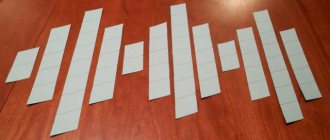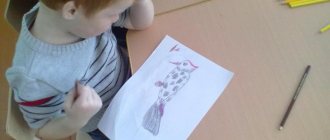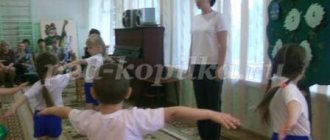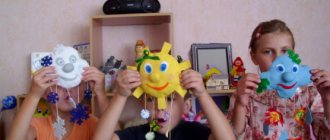Hello, dear colleagues and everyone, all my beloved readers. With you, as always, Tatyana Sukhikh, and today the topic of our discussion is how to conduct a final lesson in the senior group in accordance with the requirements of the Federal State Educational Standard. This question came to our blog from one of the readers and, what can I say, the topic is very relevant. After all, right now our beloved kids are finishing their education in preschool institutions and are about to move on to a new stage of their development - starting school.
We tried for a long time to ensure that this turning point was a joyful event for them and did not cause difficulties. And to show everything that preschoolers have learned in kindergarten groups, there are final open classes, which are usually attended by educators and primary school teachers. Since the question asked did not specify the specific topic of the lesson, I will give several examples of summing up. Namely in mathematics, grammar, ecology and natural history, drawing, as well as physical education.
Grammar Adventures
And again, first of all, we determine the knowledge that your preschooler needs upon completion of training at a preschool educational institution. These include:
- knowledge of letters (alphabet);
- definition of vowels and consonants;
- isolating sounds (letters) from a word;
- selection of words starting with a given letter;
- reading words and simple sentences by syllables;
- understanding the meaning of a sentence (where it begins and ends);
- ability to hold a pen correctly;
- skill of tracing letters along the contour;
- completing speech development tasks.
As for the last point, to help prepare for the lesson, a manual with complex lessons compiled in accordance with the requirements of the Federal State Educational Standard “Formation of coherent speech in children 4-6 years old: planning, lesson notes, lexical material” may be useful.
When compiling notes for a lesson on FEMP, it is worth considering that kids really like to pronounce sounds (letters) using the example of sounds made by animals:
- the cow makes "Moo";
- pig - “Oink-oink”;
- geese - “Ga-ga-ha”;
- ducklings - “Quack-quack-quack”;
- goat “Me-uh”;
- lamb "Be-uh."
Therefore, when going to the country of “Bukvaria” or any other country, as you call it, along the way you can meet different animals and pronounce sounds with them. If you use a CD with animal sounds, the activity will be even more interesting. You can turn on sounds and not just ask the group to pronounce them, but first guess.
Your literacy lesson could be based on the idea that letters have been stolen, and in order to get them back, the children need to go to the fictional country of “Bukvaria”, and then find the stolen alphabet by completing some tasks.
For the lesson, you can make a tree of Knowledge out of paper, on which, according to the scenario, leaves with letters should be hung. But since the Alphabet was stolen, your tree will stand without leaves and the children will have to put all the letters together. They can be hidden similarly to the geometric shapes from the previous math lesson. But let your kids find not all the letters (you will simply put some in a secret place). And after all the found leaves are attached to the tree, your students will need to name the missing components of the Alphabet.
After the guys complete this task, we move on to a more difficult stage - adding syllables from letters. To begin, review the vowels with the children. Remind the kids that vowel letters can be sung: “a-a-a”, “e-e-e”, “e-e-e”, “i-i-i”, “o-o-o”, “u-u-u”, “y-y-y”, “uh-uh”, “yu-yu-yu”, “i-i-i”.
Then line them up on different sides with vowels and consonants. Children will have to find the right pair to make a syllable.
In order to test the reading comprehension skills of your students in accordance with the requirements of the Federal State Educational Standard, write on the board a small and simple text of a letter from the villains who stole the Alphabet and invite the children to read it.
It may be more convenient for you to use cards with this very text, which you will distribute to each participant in the lesson. And let them each read one or two words from the text.
And finally, let's not forget that our tree of knowledge is still missing leaves. We can return them in this way: take the cards with letters hidden in a secret place and come up with words that will be named after these letters. You tell the children a word, they guess what letter it begins with, and you attach this very letter to the tree of Knowledge. This way you will return all the stolen components of the Alphabet to your “Alphabet” and the lesson can be considered completed.
Particular attention should be paid to the final literacy lesson in the speech therapy group. And the guide “Speech Development in Children of Senior Preschool Age” can help with this.
As in the first and second cases, do not forget to take active breaks with group games, dancing or other physical exercises related to the topic of the lesson, so that the kids do not have time to get tired. You can watch the video below for a good example of a literacy lesson. For example, I really liked it and if the opportunity arises, I will definitely try this trip in my group.
Goals
Why do we need a final integrated lesson in the senior group? The main tasks will be to consolidate and generalize the material covered. Development of speech, strengthening of initial mathematical and logical knowledge, testing the performance of hand motor skills, development of speech and awakening in children the desire to independently solve the tasks assigned to them. The teacher may set additional goals, depending on the focus of the kindergarten. For example, if this is a group with intensive study of the English language in a private kindergarten, you can add elements that reinforce knowledge in this area.
On nature
Having warmed up, you can proceed directly to the lesson. If the weather and the territory of the kindergarten allows you, go outside. Where else to conduct a final integrated lesson about the forest? The older group should be able to distinguish between several tree species and know birds and animals. Even if you don’t have many different trees growing in your garden, you can always prepare several images with plants in advance. Remember that children should be able to identify the most famous breeds by the leaves on them.
For parents
Since we have decided that our goal is to identify weaknesses, it means we need to show them to our parents. Of course, it would be possible to simply tell them the results after the lesson, but it is much better if the “mothers” who consider their child ideal can see everything with their own eyes. Therefore, conduct an open final integrated lesson in the senior group. Find a convenient time and invite moms and dads to watch the show. By the way, if you consider that there are usually 20-25 children in a group, then it is quite possible to come to an agreement with their parents and hire a professional animator to conduct the lesson. Believe me, he will cope no worse than the teacher.
World structure
No, this is not religion or politics. Children should be able to understand that everything goes on as usual - morning, afternoon, evening, night. The seasons should also be included in the final integrated lesson in the senior group. Spring and autumn, summer and winter. The child must understand that they come one after another in a certain order, and corresponding changes occur in the world. This is necessary so that the child does not freak out and does not draw conclusions like this: “You don’t buy me ice cream because stupid autumn has come!”
Check if the children know how different animals prepare for winter. Who hibernates, who stores food, and who changes their “fur coat”? How do fish survive winter? What kind of human behavior does this look like?
Autumn is harvest time. Can students identify berries? Currants, raspberries, blueberries. Do they know about mushrooms - poisonous and simply dangerous?
Summer. Considering this time, you can test children's knowledge about safety precautions. On the street, lake or just in the forest. Do they understand that matches are not a toy?
Spring is the time of flowering. How many different colors have you learned over the past year? What are their names? Who pollinates them?
Begin
So, you have chosen the setting for your future activity. Now let's figure out what exactly needs to be done on it. Your first step will be a healthy warm-up. It’s unlikely that you forced the kids to do it every day, but during the final lesson they will have to move a lot, perhaps even run outside, and to avoid injuries they need a little training.
- Here's an example: you are looking for a stolen treasure that you will go on a journey to find. All children put their palm to their forehead. We lean forward a little and peer into the distance - from right to left, from left to right (we stretch our lower back).
- Baba Yaga takes the key to the chest with a clue from the children - the children jump around her, trying to take it away (we stretch our legs).
- To warm up your hands, you can throw balls into a basket. Once it is full, the next clue in the journey opens.
Calm
After spending a lot of time outdoors, children move back into the classroom. This is a good time to conduct a final integrated Origami lesson. The older group should already have a good grasp of basic paper skills. And this is also your task. If a 6-year-old child cannot assemble a simple construction set, then this is a failure of his teachers. It's the same with paper. Many people know the legend about a sick girl who tried to collect a thousand cranes, because this was supposed to save her from an incurable disease. Nobody demands such feats from your charges. But you need to be able to assemble an airplane, a steamship, a windmill, a snowflake and many other objects that children can make. What else might the final integrated lesson “Origami” mean? The older group should be able to make simple crafts from scrap materials - plasticine, pine cones, chestnuts, leaves. This will allow you to check the work and level of development of children's imagination. Don’t give them any boundaries or boundaries; let them try to create a craft on any topic they like.
Standard
Before we start creating a lesson plan, let's talk about everything at once. For example, the standards by which the final integrated lesson should be conducted are the Federal State Educational Standard. The older group, like any other group in kindergarten, is not taken into account in federal standards. That is, you can familiarize yourself with the list of knowledge that a child should have for school, but teaching methods for preschool children are not indicated anywhere. This is where kindergartens appear with training based on the methods of various “renowned” psychologists, whose methods collapse as soon as there is at least one non-standard person in the group.
Format
How to conduct a final integrated lesson in the senior group? The first step is to choose the subject of your lesson. Since this is not a standard ordinary lesson, it would be better to draw up a rough plan of action and the setting, theme and characters that will “help” the children. What can the final integrated lesson in the senior group offer children? Traveling will be a great option where children can try out all the skills they have been taught for several years. Remember that for such an event you may need decorations. In principle, nothing particularly complicated. You can gradually make them in drawing/crafts classes throughout the year: a couple of trees, grass, a drawing of a river, a house - it all depends on where you are going to “send” the children.
Afterword
Remember: the final integrated lesson in the senior group is held in order to summarize and consolidate everything learned over the past year, and not to teach children what they have not understood over the past time. You can guide them on their “journey”, but not decide or explain to them how to cope with this or that problem. You must show parents that it was not in vain that their children attended kindergarten, that they learned a lot and became more or less independent.
Parents! If you are invited to such a lesson, be sure to attend it. Take time off from work. It is important for your child that you pay attention to him and monitor his progress. If something doesn’t work out for him, if you notice that your child is worse than others in some area, do not scold him. Better try to find out the reason for the failure, help him overcome this step. After all, the lesson is not held to brag about whose child is better, but to show how much the children have grown and matured.
Physics
Children should have a general understanding of the properties of physical objects: which ones are harder, which ones are softer, be able to compare sizes by eye and determine the material from which objects are made. All this is learned by comparing and superimposing objects on each other. It’s too late to test these skills by collecting “pyramids,” but it’s easy to be able to determine from afar which object differs from others in size.
Test children's drawing knowledge. What colors will be obtained by mixing red and yellow, yellow and blue? Knowing how the properties of objects change when mixed are the most commonplace examples. For example, you can conduct the following experiment.
- Pour water into a glass. Then sprinkle pepper or just a dark seasoning on top. If you dip your finger in water under normal conditions, traces of seasoning will remain on it. How to make sure that your finger remains clean when lowered into water? Answer: first soak it in vegetable oil, then when immersed in water, the seasoning particles will spread away from it.
- Diffusion. Although no, not like that. Mixing. Conduct an experiment on mixing sand. Do you know that the sand on beaches, sandboxes and rivers is different in color? Stock up on colored sand in advance; you can use sugar. Start pouring sand into a bottle in layers. You will get a very beautiful pattern. But children will be able to understand how mixing occurs and that it is impossible to separate the resulting mixture.
- Another experience with sand. Place a light plastic ball with a hint for the “journey” at the bottom of the jar. How to get it out without turning the jar over and without touching the ball? Start pouring sand inside, shaking it little by little. The sand will get under the ball and lift it to the top. You can also pour water inside, which will push it up.
Basics
As you go on your “journey” with your students, you must test the knowledge that is basic for any person. The Federal State Educational Standard recommends that children be able to count to 10 and know the correct order of numbers. However, counting to 100 is quite within the capabilities of a modern child, if he is engaged in his development and upbringing, and not left in the care of a tablet and computer. However, what framework to set is up to you to decide.
In addition to mathematics, it is imperative to test the ability to read and clearly express your thoughts. It’s one thing when a child is embarrassed and stutters when reading aloud, but it’s another thing when little has been done with him. It is at this stage that the final integrated speech therapist session is held in the senior group. It is not necessary to test reading speed or force you to memorize a poem, but the ability to understand what you read and expressively use intonation is necessary.




